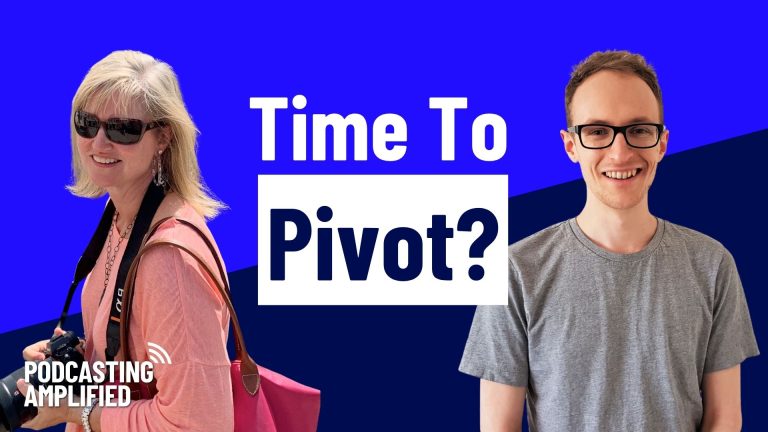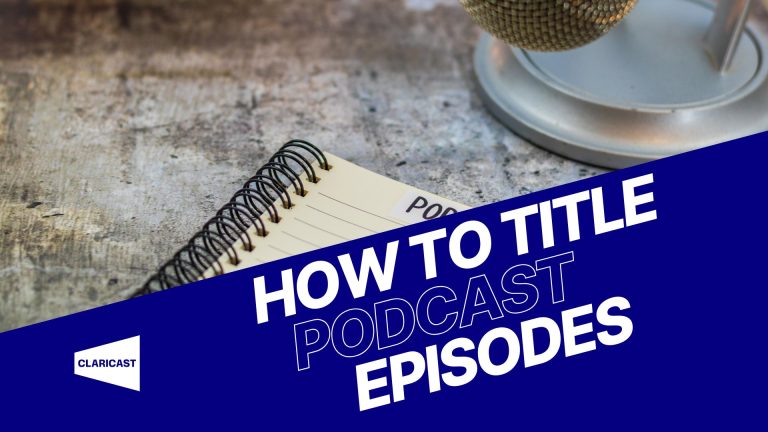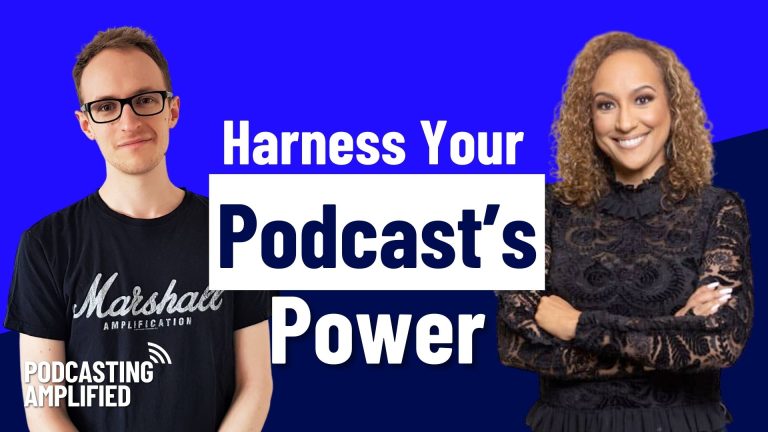You want to get more podcast listeners. Of course you do. The message that you have to share needs to be heard! But unfortunately, simply building it doesn’t necessarily mean they will come…

There are currently over four million podcasts in existence, according to Podcast Index. It’s becoming harder to get noticed and more difficult to ‘be the first’ in any particular niche. So you need to actively work on getting your podcast in front of your ideal listeners. Let me share with you 7 ways in which you can do that.
Your Ideal Listener
Before we get into the tips, I will point out that it’s essential that you know who your ideal listener is. And I’m not talking about rough demographics like “men between the ages of 18 and 45”. You need to get more specific.
Think about an actual person who is your ideal listener. They could be someone you know who listens to your podcast, or someone you’ve made up. Give them a name. Like Jason. Jason is your ideal listener. He listens to every episode you publish and he’s given your show a 5-star review. He shares your episodes on social media and he’s signed up to your mailing list.

Why does Jason listen to your podcast? What is it exactly that he wants to get out of it? What are his values and his attitudes towards the industry or niche that your podcast covers? What would put him off listening one week? What does he want from you as the host?
Every piece of content you make and every marketing activity you carry out should be done with your ideal listener in mind. If you know exactly who you’re making your podcast for and dial in your content to fit their needs, you will find it much easier to make decisions about what will grow your listener base going forward.
I’ll go more in-depth on this in another article. And don’t worry too much if who you believe your ideal listener to be changes down the line. Just keep them in mind.
Now let’s get to the tips!
7 Ways To Get More Podcast Listeners
1. Make consistent, quality content
Before you consider marketing activities, the most important thing for your podcast’s growth is that your episodes are of great quality and are released consistently. I know this seems obvious but consider the following. There are so many podcasts that I’ve seen promoted on Facebook groups asking for listeners. But then I click through and take a listen and oftentimes they haven’t been edited at all (seemingly), the audio quality is poor, they don’t draw me in within the first 30 seconds and sometimes they’re not even posting consistently!
There is no point in trying to get more podcast listeners if when they give your show a try, they drop off after a few minutes and never come back. It would be like trying to market a restaurant that makes bad food. If you persuade them to visit and the food is bad, you’ve likely lost that customer for life. And possibly their friends and family too…
Your show doesn’t need to be perfect from the get-go, but before you start trying to get more podcast listeners it at least needs to –
- Be dialled in on what your ideal listener wants to hear and draw them in within the first 30 seconds or so.
- Be released on a consistent schedule. You’ll ideally be posting every week, but if you only have time for one episode every two weeks, at least stick to that schedule.
- Sound good. It needs to be well-edited and recorded.
Once you’ve got these three things down, it’s time to start marketing.
2. Networking
What’s the first thing you do after launching your new episode? I bet that it’s sharing it across your social media channels. Or at least one of the first things. And I get why. It doesn’t take long and lets your followers know that you’ve launched a new episode. Nothing wrong with that.
But if you want to get more podcast listeners (not just the ones you already have), you need to get your podcast in front of ideal listeners who aren’t already following you. And one way to do this is through networking.

Where do your ideal listeners hang out? Are they small business owners in the UK? Perhaps they spend a lot of time on LinkedIn and on ‘UK small business’ Facebook groups. Be where your listeners are. Answer questions. Make connections. Share your content in the right places where it’s needed.
Which brings me onto…
3. Content
It makes sense that you’d want to share your podcast across the web. The thing with podcasts though, is that they’re typically long and can be difficult to search for. Especially for those looking for what you’re offering who haven’t heard your show yet. That’s where creating additional content for your podcast can come in handy.
Let’s say you’re on LinkedIn and you’re hoping to get your podcast seen. You could post a link to your full episode on your page. You could also post it as a comment on a question that you feel your episode could answer well. How many people will be clicking through to listen to a 45-minute-long episode though? Some, maybe. But it’s a hard sell.
What about instead of sharing your full episode, you shared a short clip? And that clip was in video format with subtitles that could be watched without them having to leave the LinkedIn app?
You’re far more likely to get eyes and ears on your show in this short-form format. And no, they’re not technically listening to your podcast at this point, but if you’ve grabbed their attention you have a better chance of them clicking through to listen to the full episode and becoming fans.
And video snippets aren’t the only form of content that you can use to get more podcast listeners. Well-written, enticing show notes in the form of blog articles can help bring in search traffic too from potential listeners searching for answers to specific questions. As can full video versions of your show posted on YouTube.
Get in touch today to find out how we can make the most of your content by repurposing it for multiple platforms.
4. Guesting
Guesting on other podcasts is a great way to get more podcast listeners because you can market your podcast to a whole other audience. Try reaching out to other podcasters and offer to be a guest on their show. The key is that when you reach out to the host, focus on how you can benefit their audience. You should only be reaching out to shows with audiences who could benefit from what you have to say anyway, so think about how you can put this across to the host.

I suggest looking out for podcasts that cover a similar topic but aren’t a direct competitor. For example, let’s say you have a podcast on nutrition. Consider what other podcasts your ideal listener might listen to. Fitness podcasts perhaps? You could then reach out to a dozen or two fitness podcasts and suggest a collaboration.
When reaching out, make sure you’ve listened to their podcast first so you can get a clear vision of how you could fit on their show. You could also offer them a spot on your show too as a further collaboration incentive, or work on a joint episode that you can publish in both of your feeds.
5. Dial in your CTA
What is the one thing that you want your audience to do after listening to your podcast? It’s likely either going to be something that grows your show (such as leaving a review or subscribing) or something that nurtures your existing audience and grows your brand. Whatever your call-to-action (CTA) is, make sure you don’t forget to drop it into every episode.
Plan what your CTA will be and choose where it should go in your episodes. Perhaps once during your show or in the intro (ideally, after you’ve given the listener something of value) and once in the outro to remind them. If you have sponsors then you may be more limited in where you can add in your own CTA, but if you keep it short and sweet you should be able to fit it in.
It should be concise and focused so it doesn’t bore or confuse your listeners.
6. Ask for Reviews the Right Way
This follows on from tip 5. If you want lots of good reviews, you have to make your request more than just “please leave us a review”. I’m not saying that won’t get you any reviews, but there are a couple of other methods that might help grow your pool of reviews faster. Those two ways are through incentives and personal review requests. Let’s break these down.
Incentives
What can you offer your listeners in exchange for them leaving a review? If you have the budget, a competition where you offer a random reviewer some merch or a voucher can be very effective. If you don’t have the money to invest, though, you could offer your listeners a shout-out on an episode for leaving a review.
Personal review requests
Rather than a blanket ask towards your whole audience, think about where your audience interacts with you and try directly asking for reviews there. E.g. does your podcast have a Twitter page? Or perhaps you share your episodes on LinkedIn. Ask your audience a question to do with the latest episode. This could simply be asking what they thought of the episode.
If a listener replies positively, they are a prime candidate for leaving you a quality review. Now, you can slide into their DMs and send over a quick video of yourself thanking them for their comment and asking if they wouldn’t mind putting that into a review and sending them the link. I know this sounds pretty drawn out, but personalised requests like this have a far higher chance of getting a positive response.

You can also just make a really good pitch in your episodes that puts across the importance of reviews. This is more effective if you have been nurturing your audience into becoming loyal listeners.
7. Wait!
Above all else, you’ll need to be patient. No matter how incredible your content is and how dialled in your marketing – growth takes time. It can take months to start seeing growth and even longer before you’ll start seeing exponential growth. But whatever your goals are for your podcast – it’s worth the wait!




